EX-99.1
Published on January 18, 2023
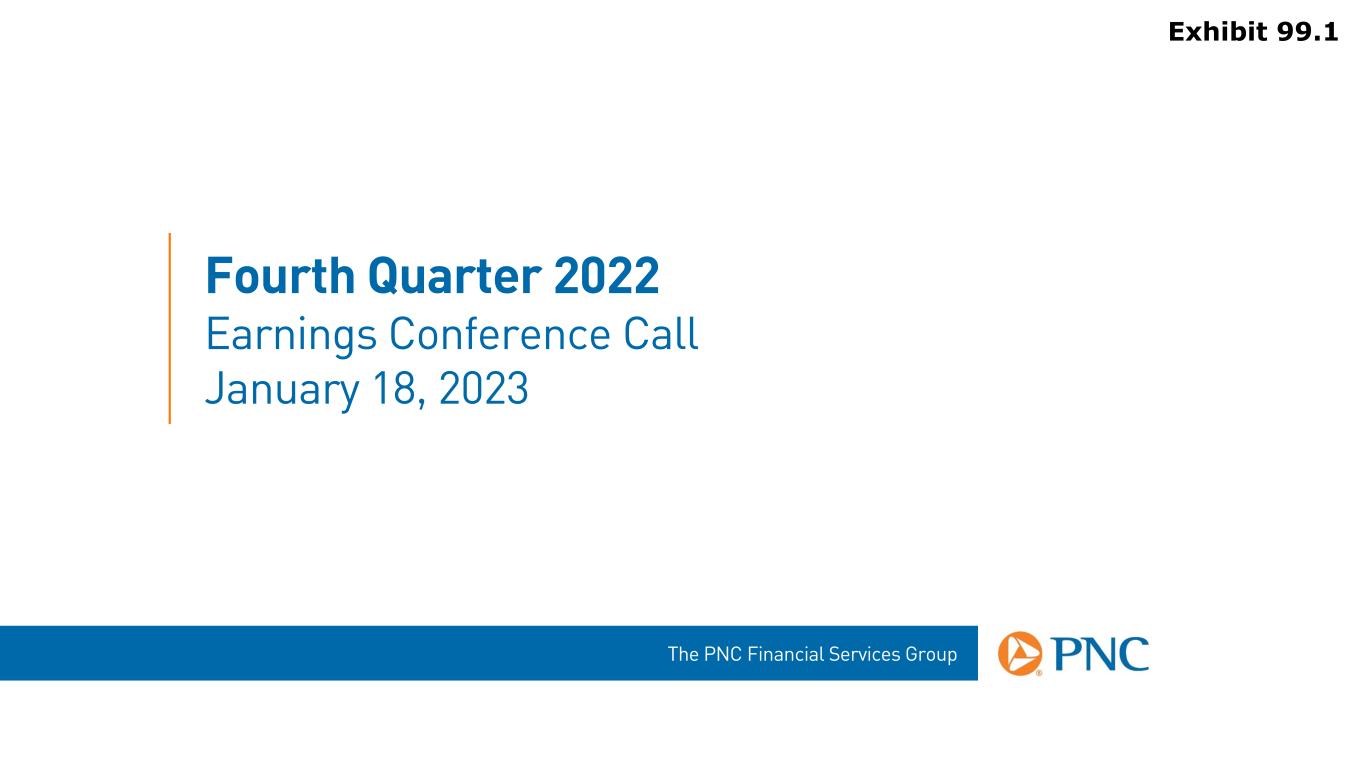
The PNC Financial Services Group Fourth Quarter 2022 Earnings Conference Call January 18, 2023 Exhibit 99.1
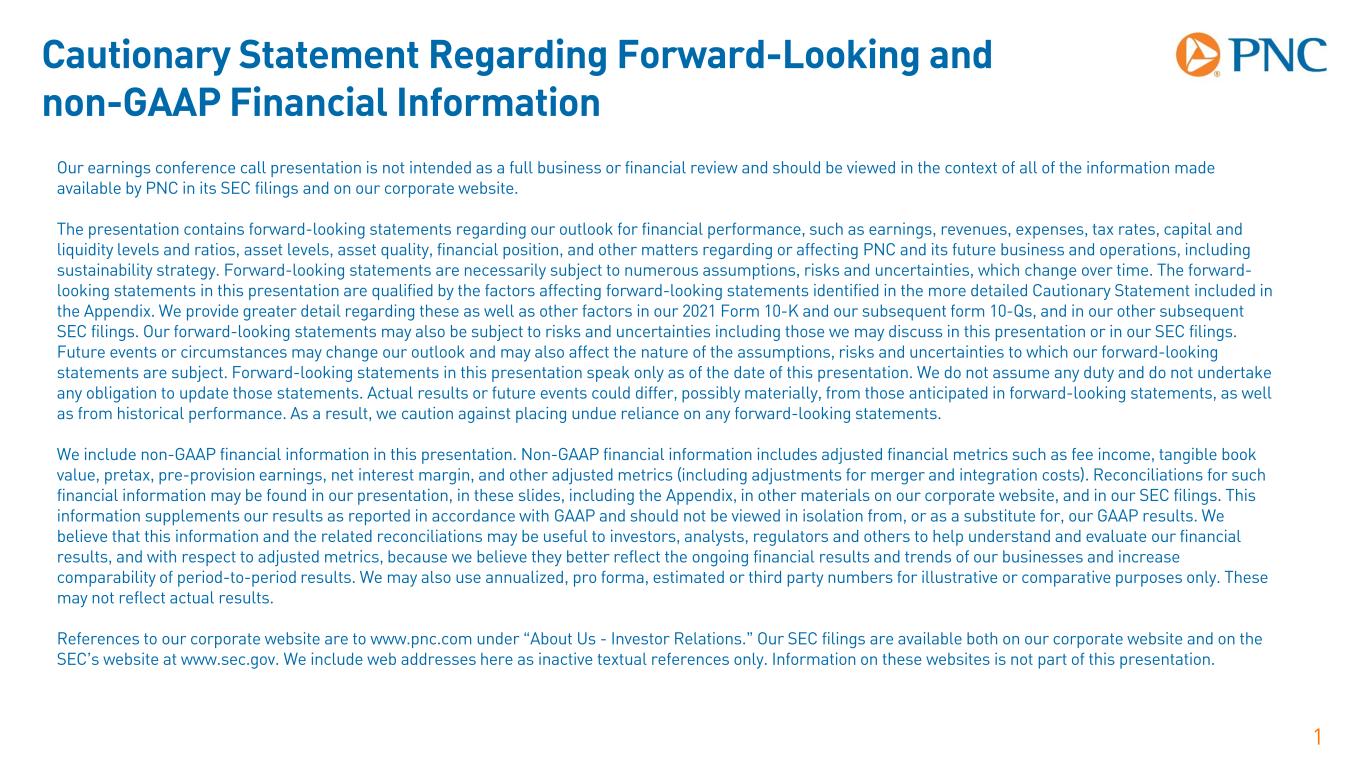
Cautionary Statement Regarding Forward-Looking and non-GAAP Financial Information Our earnings conference call presentation is not intended as a full business or financial review and should be viewed in the context of all of the information made available by PNC in its SEC filings and on our corporate website. The presentation contains forward-looking statements regarding our outlook for financial performance, such as earnings, revenues, expenses, tax rates, capital and liquidity levels and ratios, asset levels, asset quality, financial position, and other matters regarding or affecting PNC and its future business and operations, including sustainability strategy. Forward-looking statements are necessarily subject to numerous assumptions, risks and uncertainties, which change over time. The forward- looking statements in this presentation are qualified by the factors affecting forward-looking statements identified in the more detailed Cautionary Statement included in the Appendix. We provide greater detail regarding these as well as other factors in our 2021 Form 10-K and our subsequent form 10-Qs, and in our other subsequent SEC filings. Our forward-looking statements may also be subject to risks and uncertainties including those we may discuss in this presentation or in our SEC filings. Future events or circumstances may change our outlook and may also affect the nature of the assumptions, risks and uncertainties to which our forward-looking statements are subject. Forward-looking statements in this presentation speak only as of the date of this presentation. We do not assume any duty and do not undertake any obligation to update those statements. Actual results or future events could differ, possibly materially, from those anticipated in forward-looking statements, as well as from historical performance. As a result, we caution against placing undue reliance on any forward-looking statements. We include non-GAAP financial information in this presentation. Non-GAAP financial information includes adjusted financial metrics such as fee income, tangible book value, pretax, pre-provision earnings, net interest margin, and other adjusted metrics (including adjustments for merger and integration costs). Reconciliations for such financial information may be found in our presentation, in these slides, including the Appendix, in other materials on our corporate website, and in our SEC filings. This information supplements our results as reported in accordance with GAAP and should not be viewed in isolation from, or as a substitute for, our GAAP results. We believe that this information and the related reconciliations may be useful to investors, analysts, regulators and others to help understand and evaluate our financial results, and with respect to adjusted metrics, because we believe they better reflect the ongoing financial results and trends of our businesses and increase comparability of period-to-period results. We may also use annualized, pro forma, estimated or third party numbers for illustrative or comparative purposes only. These may not reflect actual results. References to our corporate website are to www.pnc.com under “About Us - Investor Relations.” Our SEC filings are available both on our corporate website and on the SEC’s website at www.sec.gov. We include web addresses here as inactive textual references only. Information on these websites is not part of this presentation. 1
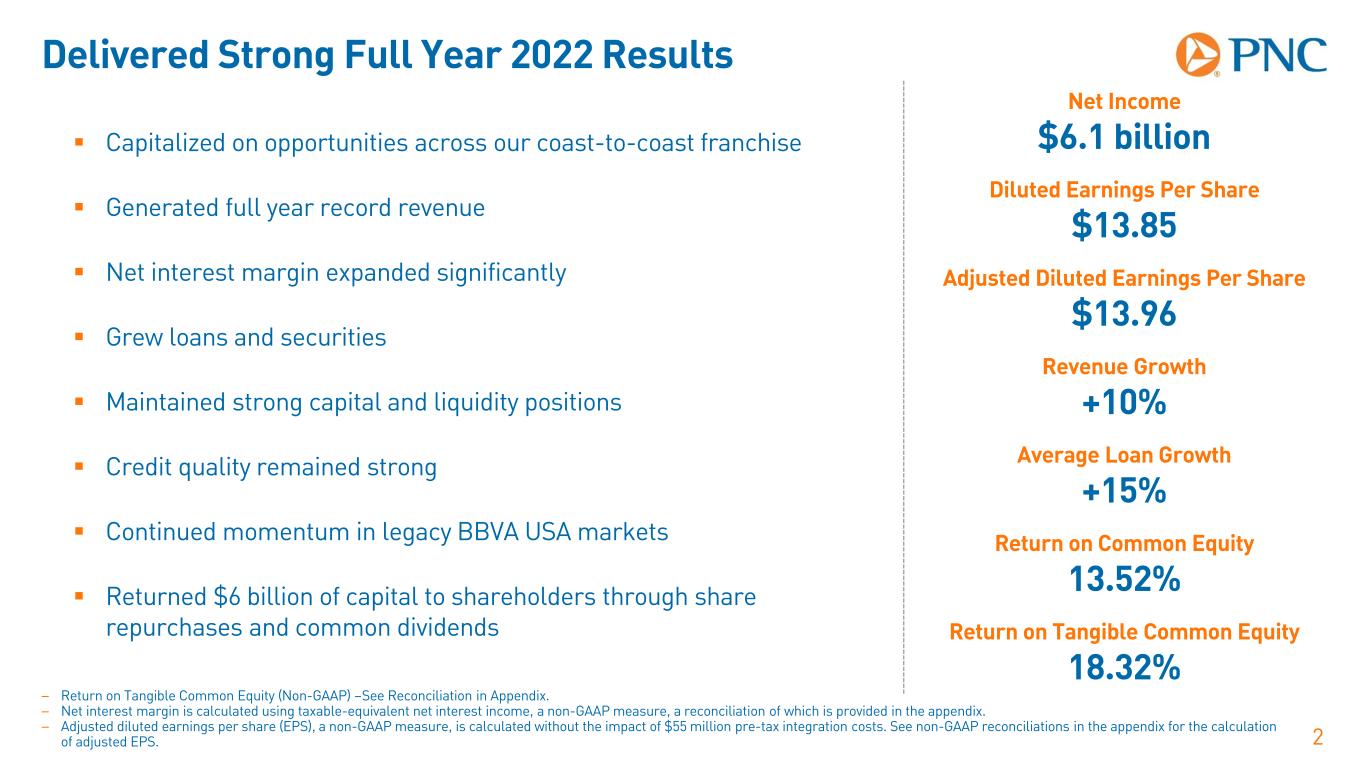
Delivered Strong Full Year 2022 Results 2 Capitalized on opportunities across our coast-to-coast franchise Generated full year record revenue Net interest margin expanded significantly Grew loans and securities Maintained strong capital and liquidity positions Credit quality remained strong Continued momentum in legacy BBVA USA markets Returned $6 billion of capital to shareholders through share repurchases and common dividends Net Income $6.1 billion Diluted Earnings Per Share $13.85 Revenue Growth +10% Average Loan Growth +15% Return on Common Equity 13.52% – Return on Tangible Common Equity (Non-GAAP) –See Reconciliation in Appendix. – Net interest margin is calculated using taxable-equivalent net interest income, a non-GAAP measure, a reconciliation of which is provided in the appendix. – Adjusted diluted earnings per share (EPS), a non-GAAP measure, is calculated without the impact of $55 million pre-tax integration costs. See non-GAAP reconciliations in the appendix for the calculation of adjusted EPS. Adjusted Diluted Earnings Per Share $13.96 Return on Tangible Common Equity 18.32%
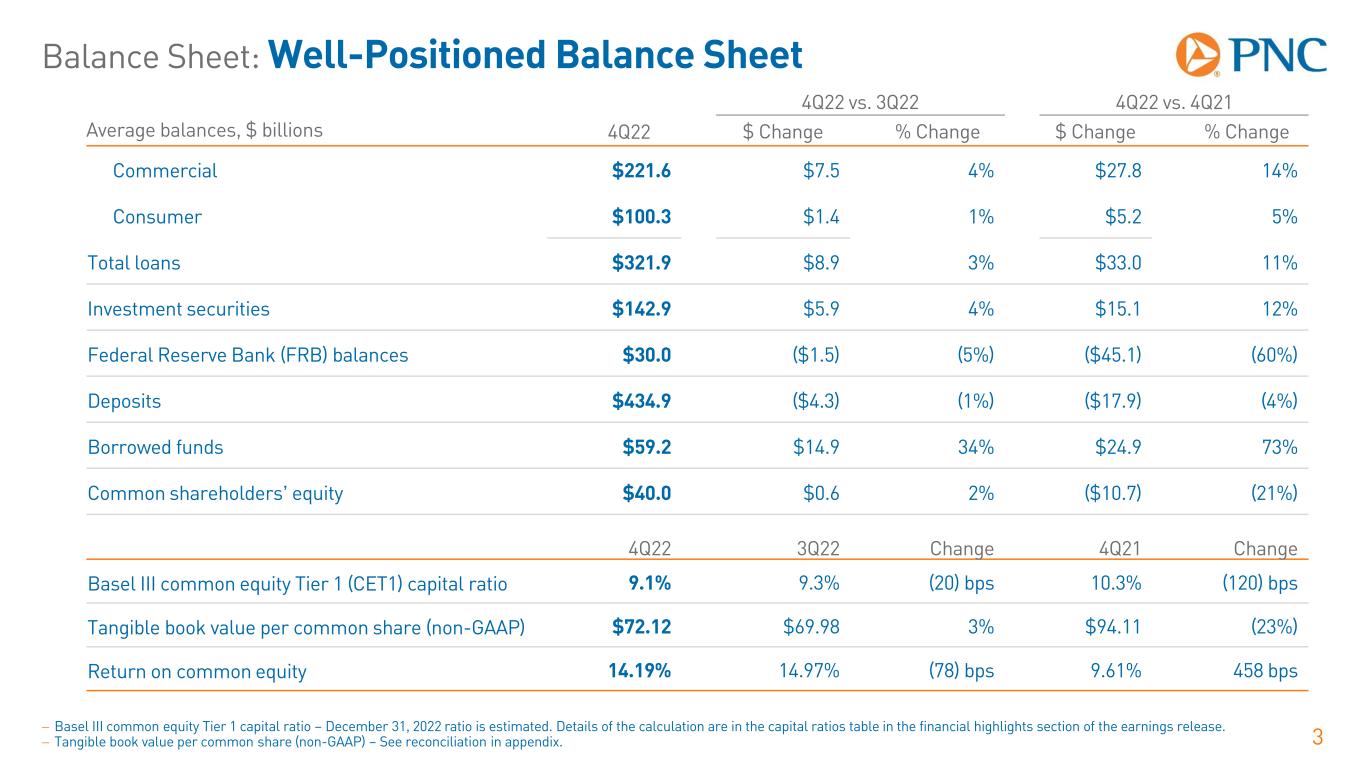
Balance Sheet: Well-Positioned Balance Sheet 3 4Q22 vs. 3Q22 4Q22 vs. 4Q21 Average balances, $ billions 4Q22 $ Change % Change $ Change % Change Commercial $221.6 $7.5 4% $27.8 14% Consumer $100.3 $1.4 1% $5.2 5% Total loans $321.9 $8.9 3% $33.0 11% Investment securities $142.9 $5.9 4% $15.1 12% Federal Reserve Bank (FRB) balances $30.0 ($1.5) (5%) ($45.1) (60%) Deposits $434.9 ($4.3) (1%) ($17.9) (4%) Borrowed funds $59.2 $14.9 34% $24.9 73% Common shareholders’ equity $40.0 $0.6 2% ($10.7) (21%) 4Q22 3Q22 Change 4Q21 Change Basel III common equity Tier 1 (CET1) capital ratio 9.1% 9.3% (20) bps 10.3% (120) bps Tangible book value per common share (non-GAAP) $72.12 $69.98 3% $94.11 (23%) Return on common equity 14.19% 14.97% (78) bps 9.61% 458 bps − Basel III common equity Tier 1 capital ratio – December 31, 2022 ratio is estimated. Details of the calculation are in the capital ratios table in the financial highlights section of the earnings release. − Tangible book value per common share (non-GAAP) – See reconciliation in appendix.
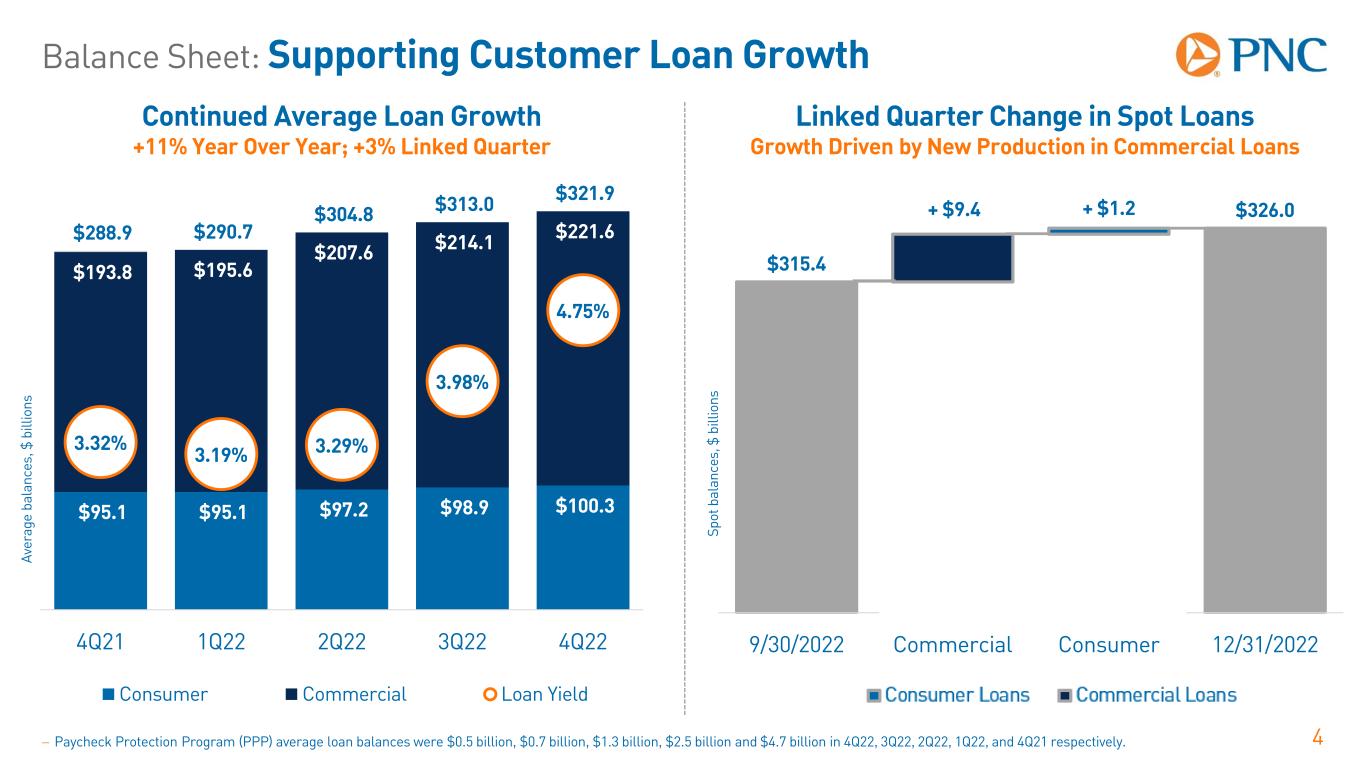
+ $9.4 + $1.2 $315.4 $326.0 250 260 270 280 290 300 310 320 330 9/30/2022 Commercial Consumer 12/31/2022 Balance Sheet: Supporting Customer Loan Growth 4 Av er ag e ba la nc es , $ b ill io ns Continued Average Loan Growth +11% Year Over Year; +3% Linked Quarter Linked Quarter Change in Spot Loans Growth Driven by New Production in Commercial Loans − Paycheck Protection Program (PPP) average loan balances were $0.5 billion, $0.7 billion, $1.3 billion, $2.5 billion and $4.7 billion in 4Q22, 3Q22, 2Q22, 1Q22, and 4Q21 respectively. $95.1 $95.1 $97.2 $98.9 $100.3 $193.8 $195.6 $207.6 $214.1 $221.6 $288.9 $290.7 $304.8 $313.0 $321.9 3.32% 3.19% 3.29% 3.98% 4.75% 1.50 % 2.00 % 2.50 % 3.00 % 3.50 % 4.00 % 4.50 % 5.00 % 5.50 % 6.00 % $- $50.0 $100.0 $150.0 $200.0 $250.0 $300.0 4Q21 1Q22 2Q22 3Q22 4Q22 Consumer Commercial Loan Yield Sp ot b al an ce s, $ b ill io ns
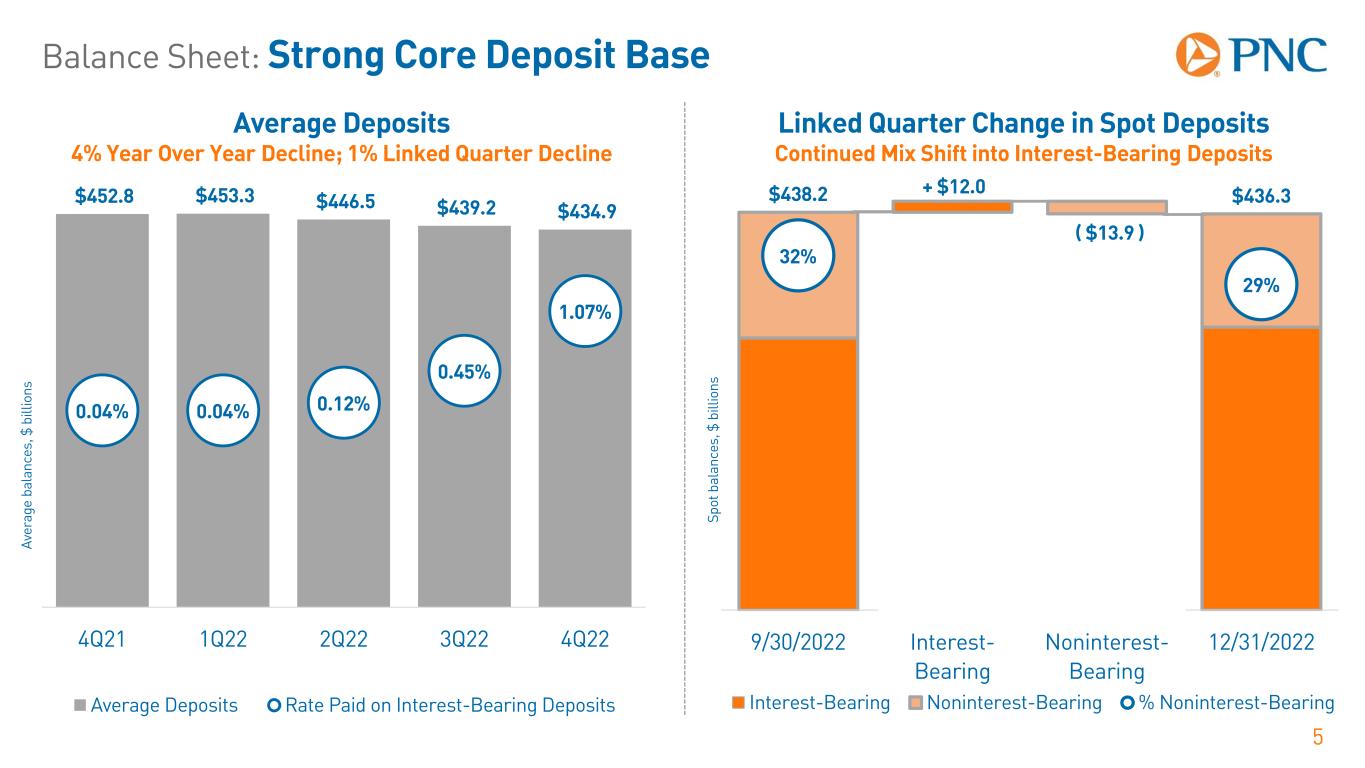
+ $12.0 ( $13.9 ) $438.2 $436.3 32% 29% $- $50.0 $100.0 $150.0 $200.0 $250.0 $300.0 $350.0 $400.0 $450.0 9/30/2022 Interest- Bearing Noninterest- Bearing 12/31/2022 Interest-Bearing Noninterest-Bearing % Noninterest-Bearing $452.8 $453.3 $446.5 $439.2 $434.9 0.04% 0.04% 0.12% 0.45% 1.07% 4Q21 1Q22 2Q22 3Q22 4Q22 Average Deposits Rate Paid on Interest-Bearing Deposits Balance Sheet: Strong Core Deposit Base 5 Average Deposits 4% Year Over Year Decline; 1% Linked Quarter Decline Av er ag e ba la nc es , $ b ill io ns Linked Quarter Change in Spot Deposits Continued Mix Shift into Interest-Bearing Deposits Sp ot b al an ce s, $ b ill io ns
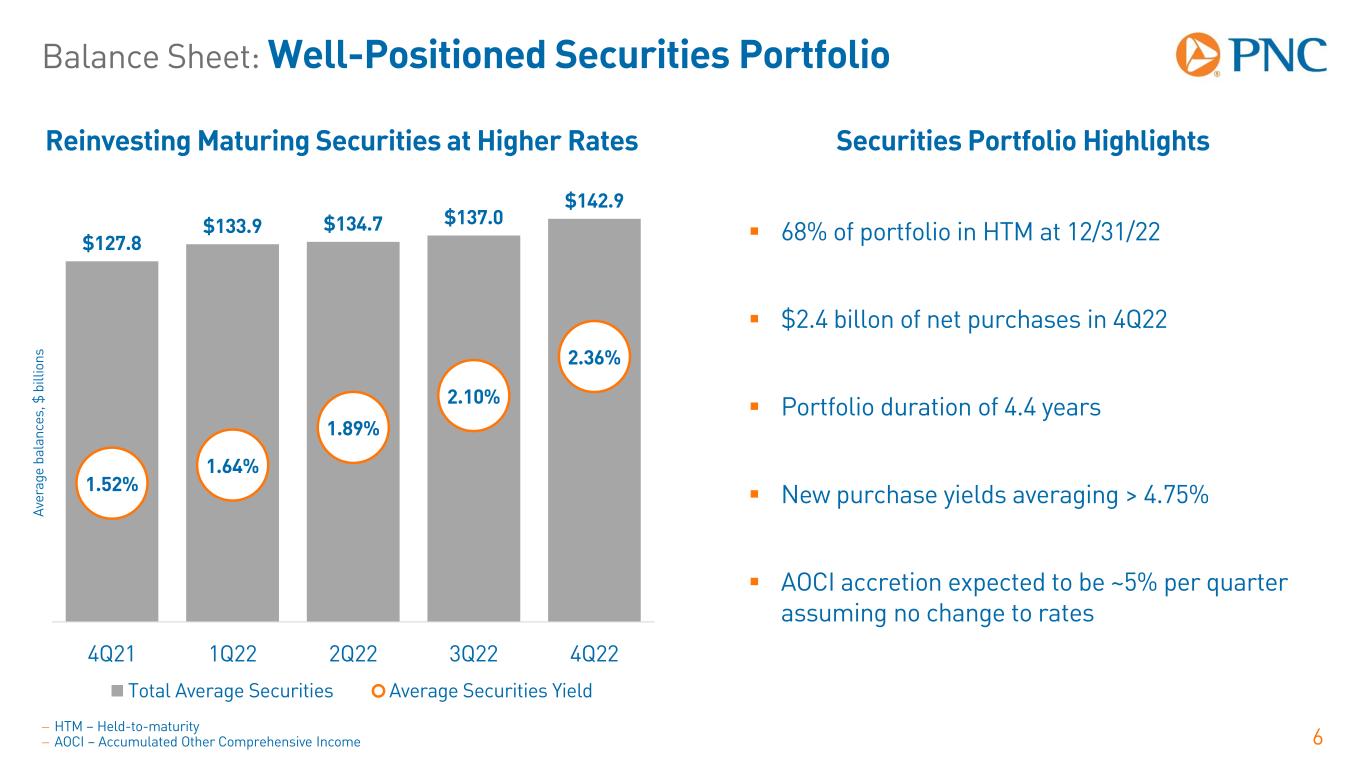
Balance Sheet: Well-Positioned Securities Portfolio 6 Securities Portfolio Highlights Av er ag e ba la nc es , $ b ill io ns Reinvesting Maturing Securities at Higher Rates $127.8 $133.9 $134.7 $137.0 $142.9 1.52% 1.64% 1.89% 2.10% 2.36% 0 20 40 60 80 100 120 140 4Q21 1Q22 2Q22 3Q22 4Q22 Total Average Securities Average Securities Yield 68% of portfolio in HTM at 12/31/22 $2.4 billon of net purchases in 4Q22 Portfolio duration of 4.4 years New purchase yields averaging > 4.75% AOCI accretion expected to be ~5% per quarter assuming no change to rates − HTM – Held-to-maturity − AOCI – Accumulated Other Comprehensive Income

Income Statement: Solid Performance 7− Non-GAAP reconciliations are in the appendix slides. − Net interest margin is calculated using taxable-equivalent net interest income, a non-GAAP measure, a reconciliation of which is provided in the appendix. 4Q22 vs. 3Q22 2022 vs. 2021 $ millions 4Q22 $ Chg. % Chg. 2022 $ Chg. % Chg. Revenue $5,763 $214 4% $21,120 $1,909 10% Noninterest expense 3,474 194 6% 13,170 168 1% Pretax, pre-provision earnings (non-GAAP) $2,289 $20 1% $7,950 $1,741 28% Integration costs 9 8 n/m 55 (743) n/m Pretax, pre-provision earnings ex. integration costs (non-GAAP) $2,298 $28 1% $8,005 $998 14% Provision for credit losses $408 $167 69% $477 $1,256 n/m Income taxes 333 (55) (14%) 1,360 97 8% Net income $1,548 ($92) (6%) $6,113 $388 7% 4Q22 3Q22 Chg. 2022 2021 Chg. Noninterest income to total revenue 36% 37% (100) bps 38% 45% (700) bps Net interest margin 2.92% 2.82% 10 bps 2.65% 2.29% 36 bps Diluted EPS $3.47 $3.78 (8%) $13.85 $12.70 9% Diluted EPS ex. integration costs (non-GAAP) $3.49 $3.78 (8%) $13.96 $14.18 (2%)
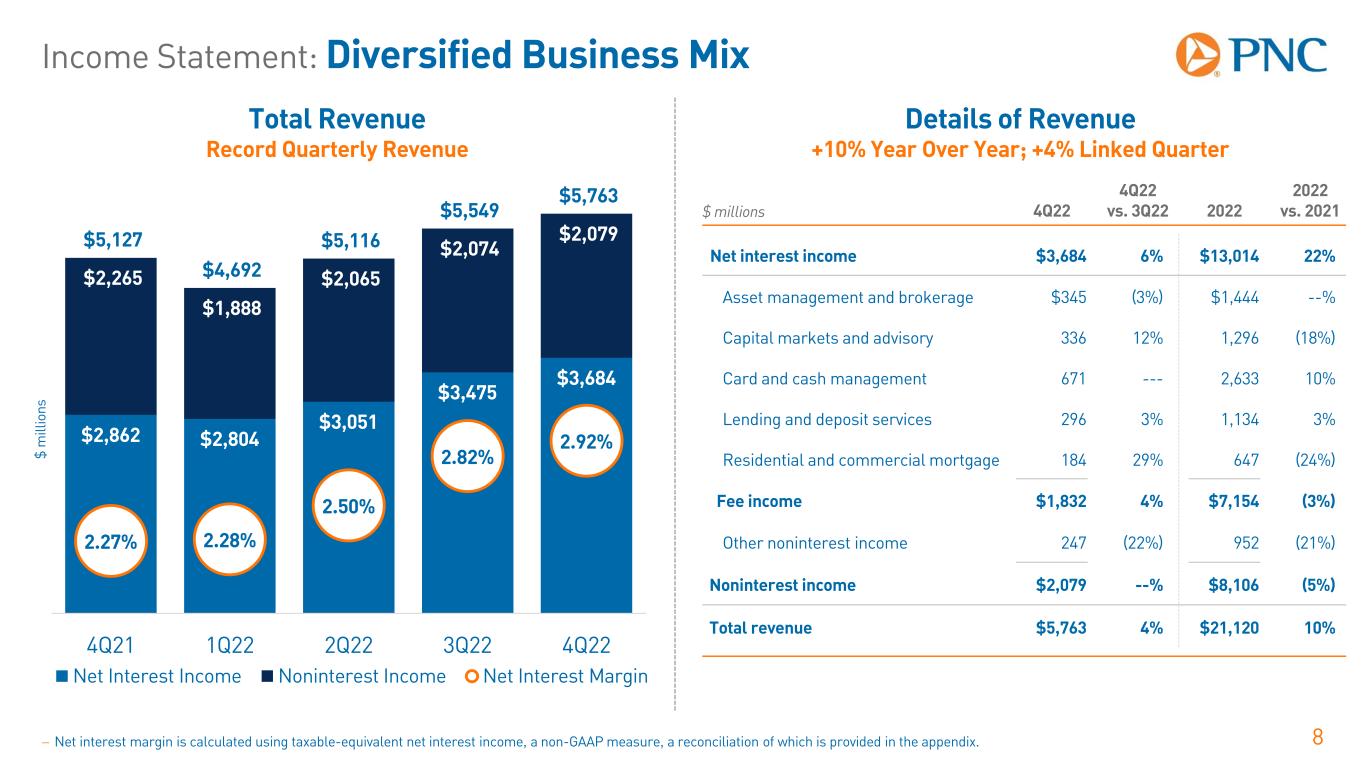
Income Statement: Diversified Business Mix 8 Total Revenue Record Quarterly Revenue Details of Revenue +10% Year Over Year; +4% Linked Quarter $ m ill io ns − Net interest margin is calculated using taxable-equivalent net interest income, a non-GAAP measure, a reconciliation of which is provided in the appendix. $2,862 $2,804 $3,051 $3,475 $3,684 $2,265 $1,888 $2,065 $2,074 $2,079 $5,127 $4,692 $5,116 $5,549 $5,763 2.27% 2.28% 2.50% 2.82% 2.92% 1.80 % 2.30 % 2.80 % 3.30 % 3.80 % 4.30 % 0 100 0 200 0 300 0 400 0 500 0 600 0 4Q21 1Q22 2Q22 3Q22 4Q22 Net Interest Income Noninterest Income Net Interest Margin $ millions 4Q22 4Q22 vs. 3Q22 2022 2022 vs. 2021 Net interest income $3,684 6% $13,014 22% Asset management and brokerage $345 (3%) $1,444 --% Capital markets and advisory 336 12% 1,296 (18%) Card and cash management 671 --- 2,633 10% Lending and deposit services 296 3% 1,134 3% Residential and commercial mortgage 184 29% 647 (24%) Fee income $1,832 4% $7,154 (3%) Other noninterest income 247 (22%) 952 (21%) Noninterest income $2,079 --% $8,106 (5%) Total revenue $5,763 4% $21,120 10%
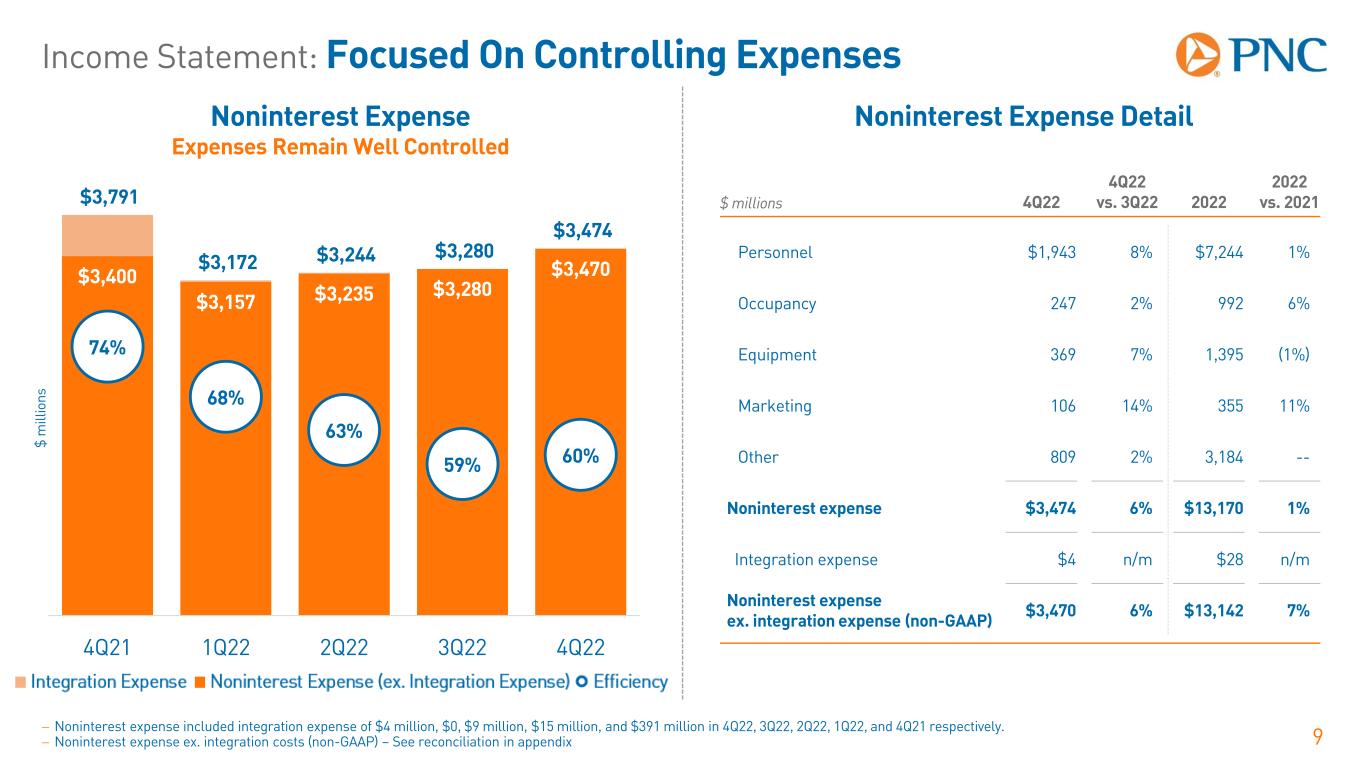
Income Statement: Focused On Controlling Expenses 9 $3,400 $3,157 $3,235 $3,280 $3,470 $3,791 $3,172 $3,244 $3,280 $3,474 74% 68% 63% 59% 60% 4Q21 1Q22 2Q22 3Q22 4Q22 Noninterest Expense Expenses Remain Well Controlled − Noninterest expense included integration expense of $4 million, $0, $9 million, $15 million, and $391 million in 4Q22, 3Q22, 2Q22, 1Q22, and 4Q21 respectively. − Noninterest expense ex. integration costs (non-GAAP) – See reconciliation in appendix $ m ill io ns Noninterest Expense Detail $ millions 4Q22 4Q22 vs. 3Q22 2022 2022 vs. 2021 Personnel $1,943 8% $7,244 1% Occupancy 247 2% 992 6% Equipment 369 7% 1,395 (1%) Marketing 106 14% 355 11% Other 809 2% 3,184 -- Noninterest expense $3,474 6% $13,170 1% Integration expense $4 n/m $28 n/m Noninterest expense ex. integration expense (non-GAAP) $3,470 6% $13,142 7%
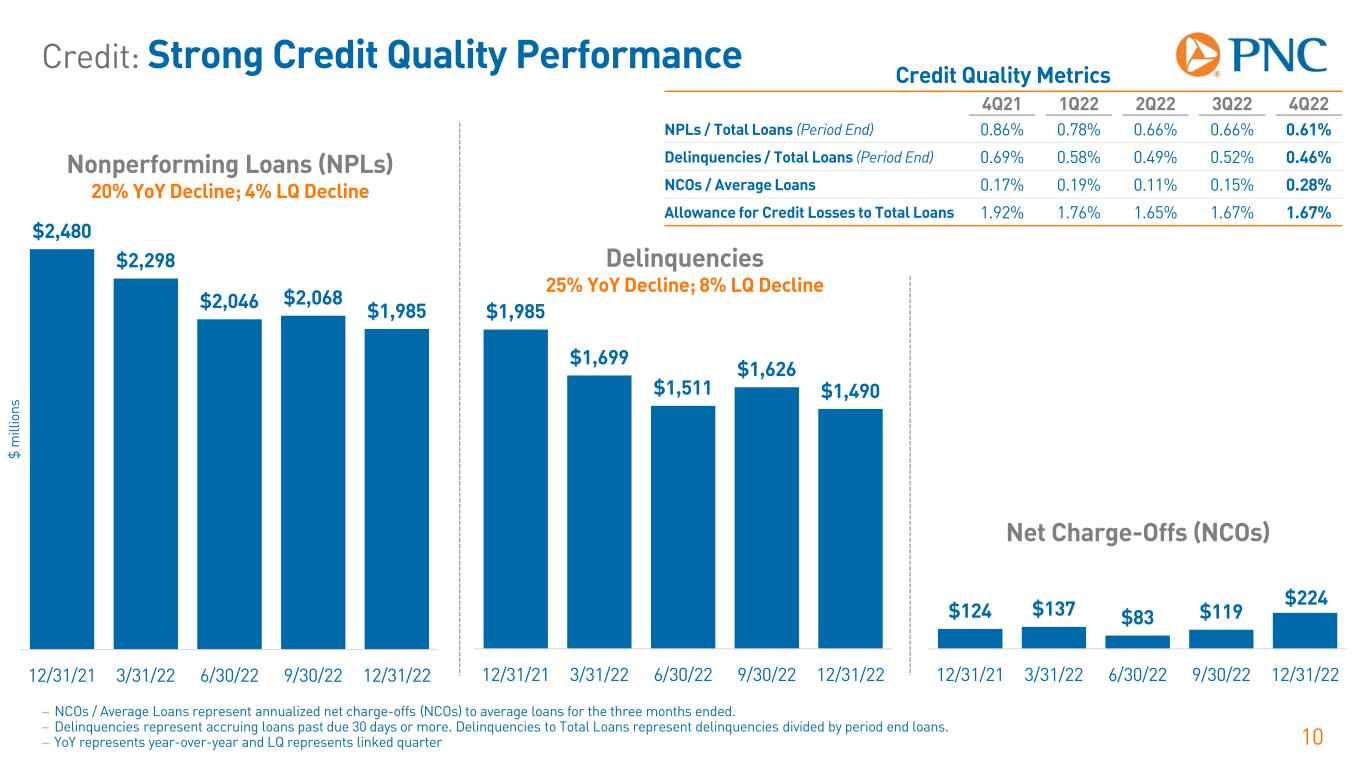
Credit: Strong Credit Quality Performance 10 − NCOs / Average Loans represent annualized net charge-offs (NCOs) to average loans for the three months ended. − Delinquencies represent accruing loans past due 30 days or more. Delinquencies to Total Loans represent delinquencies divided by period end loans. − YoY represents year-over-year and LQ represents linked quarter $1,985 $1,699 $1,511 $1,626 $1,490 12/31/21 3/31/22 6/30/22 9/30/22 12/31/22 $2,480 $2,298 $2,046 $2,068 $1,985 12/31/21 3/31/22 6/30/22 9/30/22 12/31/22 Nonperforming Loans (NPLs) 20% YoY Decline; 4% LQ Decline Delinquencies 25% YoY Decline; 8% LQ Decline Net Charge-Offs (NCOs) $224 $124 $137 $83 $119 12/31/21 3/31/22 6/30/22 9/30/22 12/31/22 Credit Quality Metrics 4Q21 1Q22 2Q22 3Q22 4Q22 NPLs / Total Loans (Period End) 0.86% 0.78% 0.66% 0.66% 0.61% Delinquencies / Total Loans (Period End) 0.69% 0.58% 0.49% 0.52% 0.46% NCOs / Average Loans 0.17% 0.19% 0.11% 0.15% 0.28% Allowance for Credit Losses to Total Loans 1.92% 1.76% 1.65% 1.67% 1.67% $ m ill io ns

Outlook: Full Year 2023 Compared to Full Year 2022 11 − Refer to Cautionary Statement in the Appendix, including economic and other assumptions. Does not take into account impact of potential legal and regulatory contingencies. − Average loans, period-end loans, revenue, and noninterest expense outlooks represent estimated percentage change for full year 2023 compared to the respective full year 2022 figure presented in the table above. ($ millions; except loans, $ billions) 2022 2023 Guidance Period-end loans (as of 12/31/22) $326.0 Up 2% - 4% Average loans $307.7 Up 6% - 8% Revenue $21,120 Up 6% - 8% Noninterest expense $13,170 Up 2% - 4% Effective tax rate 18.2% 18%
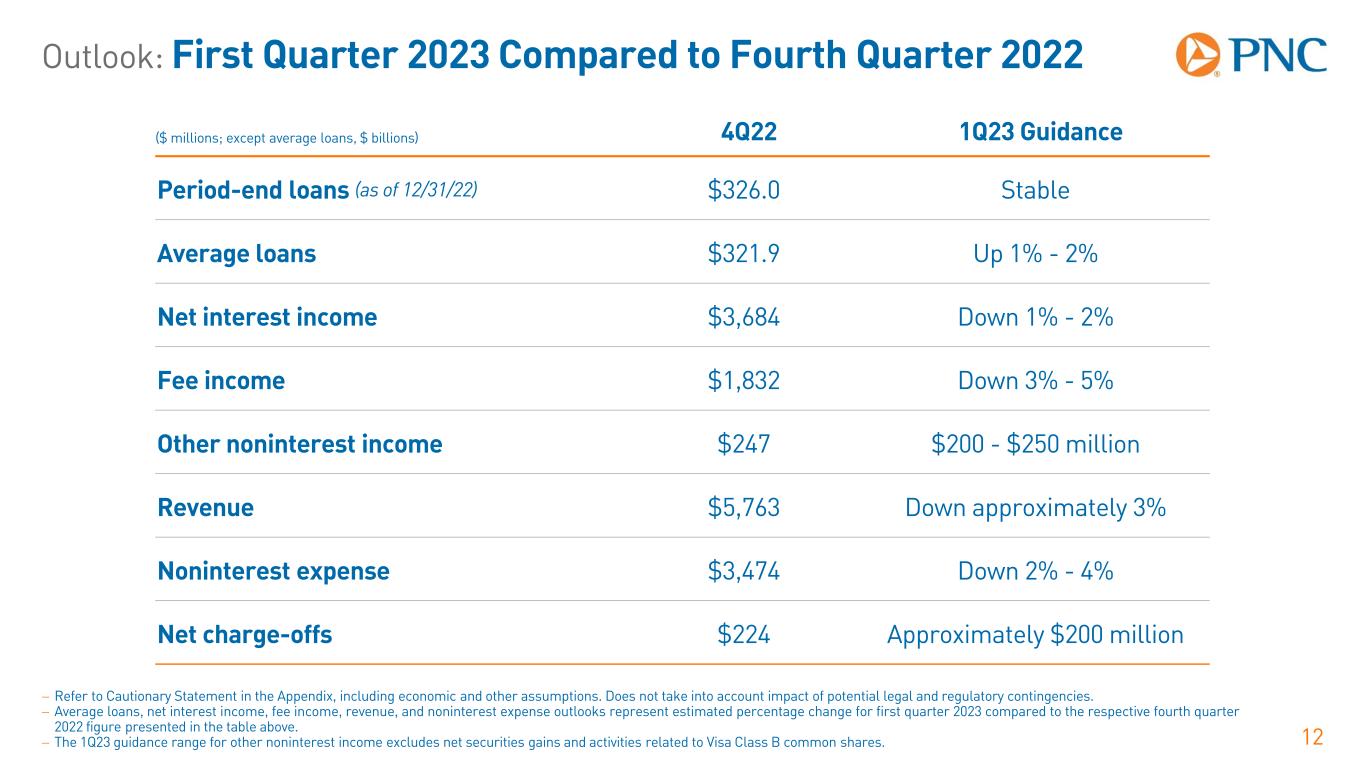
Outlook: First Quarter 2023 Compared to Fourth Quarter 2022 12 − Refer to Cautionary Statement in the Appendix, including economic and other assumptions. Does not take into account impact of potential legal and regulatory contingencies. − Average loans, net interest income, fee income, revenue, and noninterest expense outlooks represent estimated percentage change for first quarter 2023 compared to the respective fourth quarter 2022 figure presented in the table above. − The 1Q23 guidance range for other noninterest income excludes net securities gains and activities related to Visa Class B common shares. ($ millions; except average loans, $ billions) 4Q22 1Q23 Guidance Period-end loans (as of 12/31/22) $326.0 Stable Average loans $321.9 Up 1% - 2% Net interest income $3,684 Down 1% - 2% Fee income $1,832 Down 3% - 5% Other noninterest income $247 $200 - $250 million Revenue $5,763 Down approximately 3% Noninterest expense $3,474 Down 2% - 4% Net charge-offs $224 Approximately $200 million

Appendix: Cautionary Statement Regarding Forward-Looking Information 13 We make statements in this presentation, and we may from time to time make other statements, regarding our outlook for financial performance, such as earnings, revenues, expenses, tax rates, capital and liquidity levels and ratios, asset levels, asset quality, financial position, and other matters regarding or affecting us and our future business and operations, including our sustainability strategy, that are forward-looking statements within the meaning of the Private Securities Litigation Reform Act. Forward-looking statements are typically identified by words such as “believe,” “plan,” “expect,” “anticipate,” “see,” “look,” “intend,” “outlook,” “project,” “forecast,” “estimate,” “goal,” “will,” “should” and other similar words and expressions. Forward-looking statements are necessarily subject to numerous assumptions, risks and uncertainties, which change over time. Future events or circumstances may change our outlook and may also affect the nature of the assumptions, risks and uncertainties to which our forward-looking statements are subject. Forward-looking statements speak only as of the date made. We do not assume any duty and do not undertake any obligation to update forward-looking statements. Actual results or future events could differ, possibly materially, from those anticipated in forward-looking statements, as well as from historical performance. As a result, we caution against placing undue reliance on any forward-looking statements. Our forward-looking statements are subject to the following principal risks and uncertainties. Our businesses, financial results and balance sheet values are affected by business and economic conditions, including: − Changes in interest rates and valuations in debt, equity and other financial markets, − Disruptions in the U.S. and global financial markets, − Actions by the Federal Reserve Board, U.S. Treasury and other government agencies, including those that impact money supply, market interest rates and inflation, − Changes in customer behavior due to changing business and economic conditions or legislative or regulatory initiatives, − Changes in customers’, suppliers’ and other counterparties’ performance and creditworthiness, − Impacts of tariffs and other trade policies of the U.S. and its global trading partners, − The impact of the Russia-Ukraine conflict, and associated sanctions or other actions in response, on the global and U.S. economy, − The length and extent of the economic impacts of the COVID-19 pandemic, − Impacts of changes in federal, state and local governmental policy, including on the regulatory landscape, capital markets, taxes, infrastructure spending and social programs, − PNC’s ability to attract, recruit and retain skilled employees, and − Commodity price volatility.
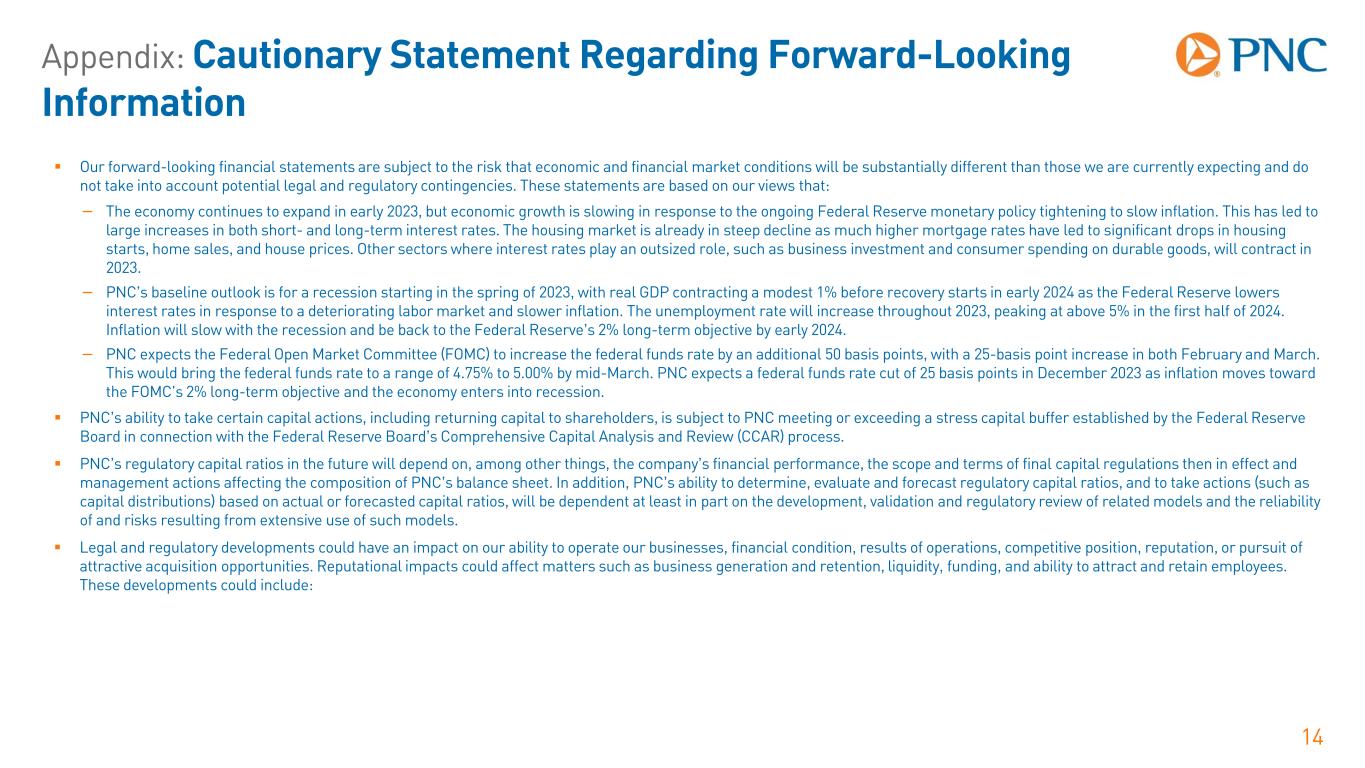
Appendix: Cautionary Statement Regarding Forward-Looking Information 14 Our forward-looking financial statements are subject to the risk that economic and financial market conditions will be substantially different than those we are currently expecting and do not take into account potential legal and regulatory contingencies. These statements are based on our views that: − The economy continues to expand in early 2023, but economic growth is slowing in response to the ongoing Federal Reserve monetary policy tightening to slow inflation. This has led to large increases in both short- and long-term interest rates. The housing market is already in steep decline as much higher mortgage rates have led to significant drops in housing starts, home sales, and house prices. Other sectors where interest rates play an outsized role, such as business investment and consumer spending on durable goods, will contract in 2023. − PNC’s baseline outlook is for a recession starting in the spring of 2023, with real GDP contracting a modest 1% before recovery starts in early 2024 as the Federal Reserve lowers interest rates in response to a deteriorating labor market and slower inflation. The unemployment rate will increase throughout 2023, peaking at above 5% in the first half of 2024. Inflation will slow with the recession and be back to the Federal Reserve’s 2% long-term objective by early 2024. − PNC expects the Federal Open Market Committee (FOMC) to increase the federal funds rate by an additional 50 basis points, with a 25-basis point increase in both February and March. This would bring the federal funds rate to a range of 4.75% to 5.00% by mid-March. PNC expects a federal funds rate cut of 25 basis points in December 2023 as inflation moves toward the FOMC's 2% long-term objective and the economy enters into recession. PNC’s ability to take certain capital actions, including returning capital to shareholders, is subject to PNC meeting or exceeding a stress capital buffer established by the Federal Reserve Board in connection with the Federal Reserve Board’s Comprehensive Capital Analysis and Review (CCAR) process. PNC’s regulatory capital ratios in the future will depend on, among other things, the company’s financial performance, the scope and terms of final capital regulations then in effect and management actions affecting the composition of PNC’s balance sheet. In addition, PNC’s ability to determine, evaluate and forecast regulatory capital ratios, and to take actions (such as capital distributions) based on actual or forecasted capital ratios, will be dependent at least in part on the development, validation and regulatory review of related models and the reliability of and risks resulting from extensive use of such models. Legal and regulatory developments could have an impact on our ability to operate our businesses, financial condition, results of operations, competitive position, reputation, or pursuit of attractive acquisition opportunities. Reputational impacts could affect matters such as business generation and retention, liquidity, funding, and ability to attract and retain employees. These developments could include:
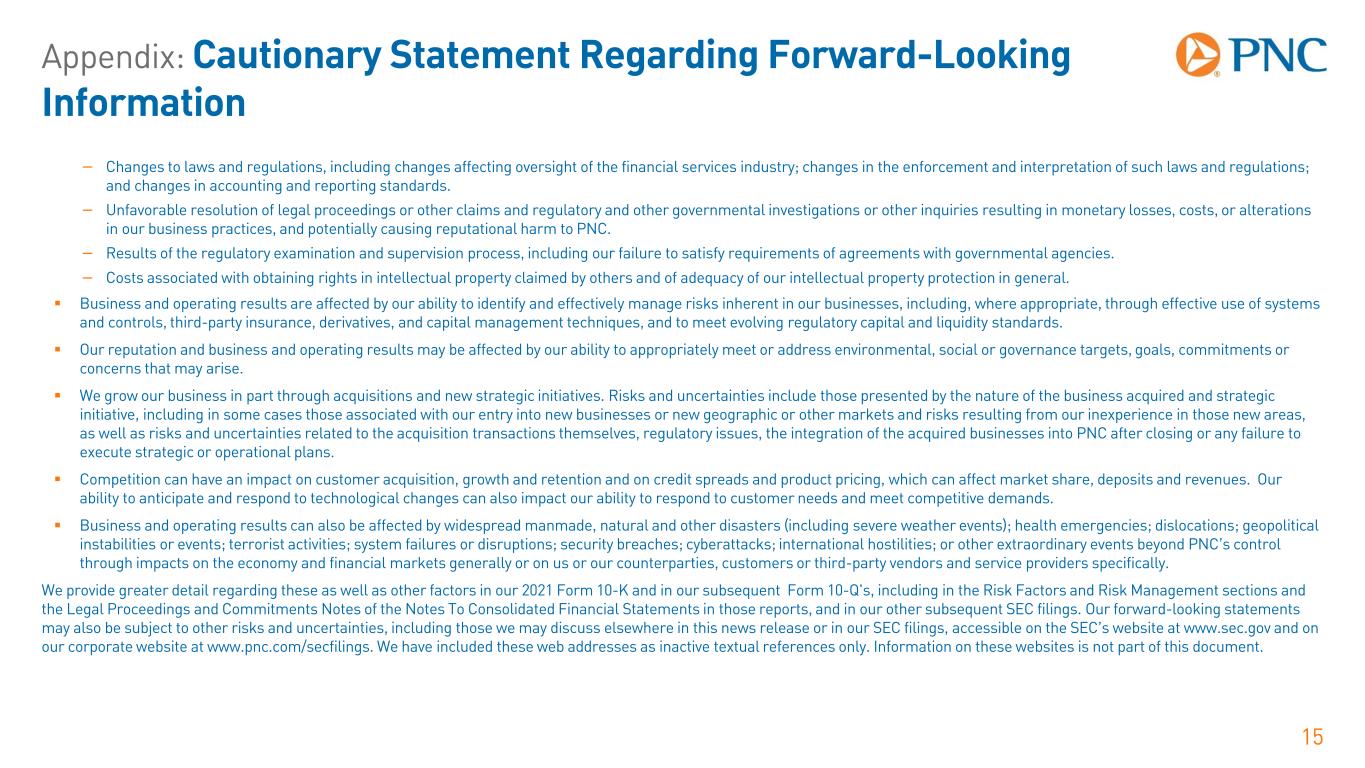
Appendix: Cautionary Statement Regarding Forward-Looking Information 15 − Changes to laws and regulations, including changes affecting oversight of the financial services industry; changes in the enforcement and interpretation of such laws and regulations; and changes in accounting and reporting standards. − Unfavorable resolution of legal proceedings or other claims and regulatory and other governmental investigations or other inquiries resulting in monetary losses, costs, or alterations in our business practices, and potentially causing reputational harm to PNC. − Results of the regulatory examination and supervision process, including our failure to satisfy requirements of agreements with governmental agencies. − Costs associated with obtaining rights in intellectual property claimed by others and of adequacy of our intellectual property protection in general. Business and operating results are affected by our ability to identify and effectively manage risks inherent in our businesses, including, where appropriate, through effective use of systems and controls, third-party insurance, derivatives, and capital management techniques, and to meet evolving regulatory capital and liquidity standards. Our reputation and business and operating results may be affected by our ability to appropriately meet or address environmental, social or governance targets, goals, commitments or concerns that may arise. We grow our business in part through acquisitions and new strategic initiatives. Risks and uncertainties include those presented by the nature of the business acquired and strategic initiative, including in some cases those associated with our entry into new businesses or new geographic or other markets and risks resulting from our inexperience in those new areas, as well as risks and uncertainties related to the acquisition transactions themselves, regulatory issues, the integration of the acquired businesses into PNC after closing or any failure to execute strategic or operational plans. Competition can have an impact on customer acquisition, growth and retention and on credit spreads and product pricing, which can affect market share, deposits and revenues. Our ability to anticipate and respond to technological changes can also impact our ability to respond to customer needs and meet competitive demands. Business and operating results can also be affected by widespread manmade, natural and other disasters (including severe weather events); health emergencies; dislocations; geopolitical instabilities or events; terrorist activities; system failures or disruptions; security breaches; cyberattacks; international hostilities; or other extraordinary events beyond PNC’s control through impacts on the economy and financial markets generally or on us or our counterparties, customers or third-party vendors and service providers specifically. We provide greater detail regarding these as well as other factors in our 2021 Form 10-K and in our subsequent Form 10-Q's, including in the Risk Factors and Risk Management sections and the Legal Proceedings and Commitments Notes of the Notes To Consolidated Financial Statements in those reports, and in our other subsequent SEC filings. Our forward-looking statements may also be subject to other risks and uncertainties, including those we may discuss elsewhere in this news release or in our SEC filings, accessible on the SEC’s website at www.sec.gov and on our corporate website at www.pnc.com/secfilings. We have included these web addresses as inactive textual references only. Information on these websites is not part of this document.
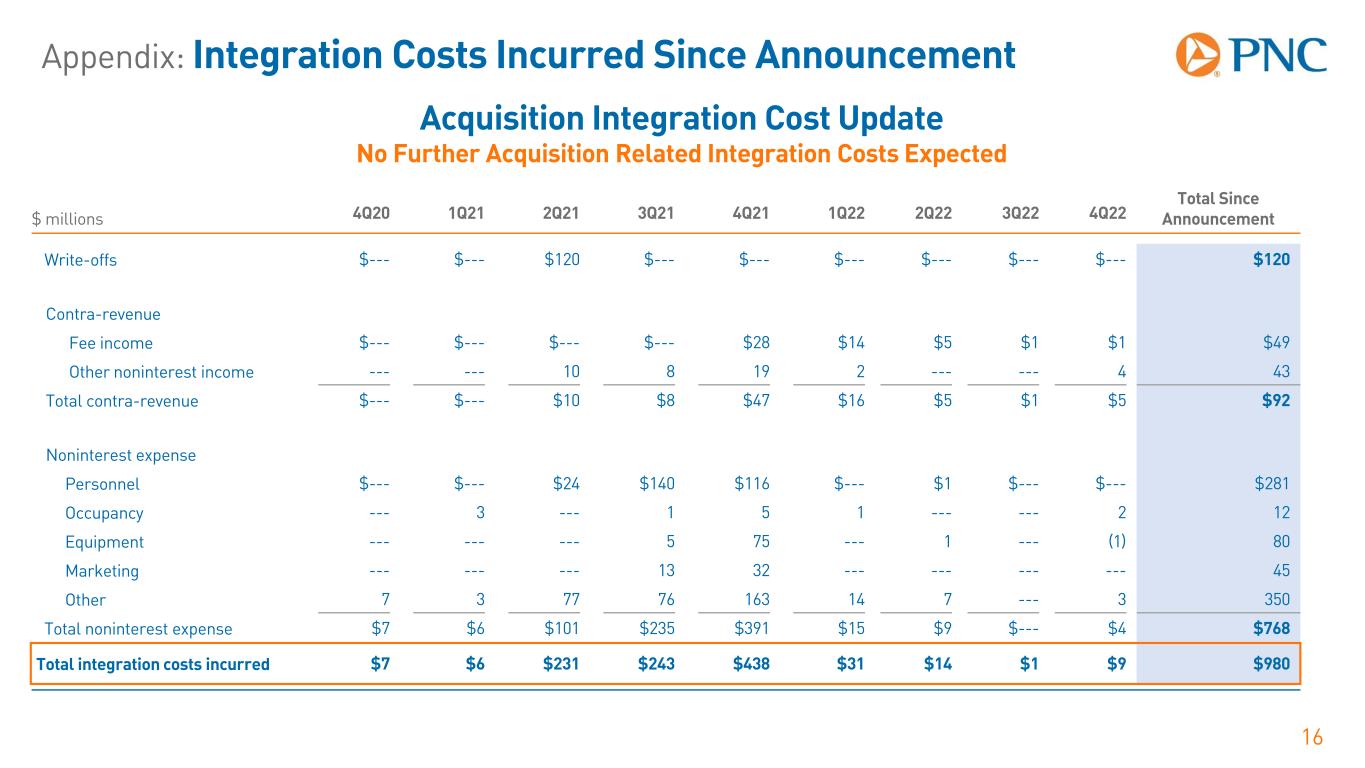
Total Since Announcement$ millions 4Q20 1Q21 2Q21 3Q21 4Q21 1Q22 2Q22 3Q22 4Q22 Write-offs $--- $--- $120 $--- $--- $--- $--- $--- $--- $120 Contra-revenue Fee income $--- $--- $--- $--- $28 $14 $5 $1 $1 $49 Other noninterest income --- --- 10 8 19 2 --- --- 4 43 Total contra-revenue $--- $--- $10 $8 $47 $16 $5 $1 $5 $92 Noninterest expense Personnel $--- $--- $24 $140 $116 $--- $1 $--- $--- $281 Occupancy --- 3 --- 1 5 1 --- --- 2 12 Equipment --- --- --- 5 75 --- 1 --- (1) 80 Marketing --- --- --- 13 32 --- --- --- --- 45 Other 7 3 77 76 163 14 7 --- 3 350 Total noninterest expense $7 $6 $101 $235 $391 $15 $9 $--- $4 $768 Total integration costs incurred $7 $6 $231 $243 $438 $31 $14 $1 $9 $980 Appendix: Integration Costs Incurred Since Announcement 16 Acquisition Integration Cost Update No Further Acquisition Related Integration Costs Expected
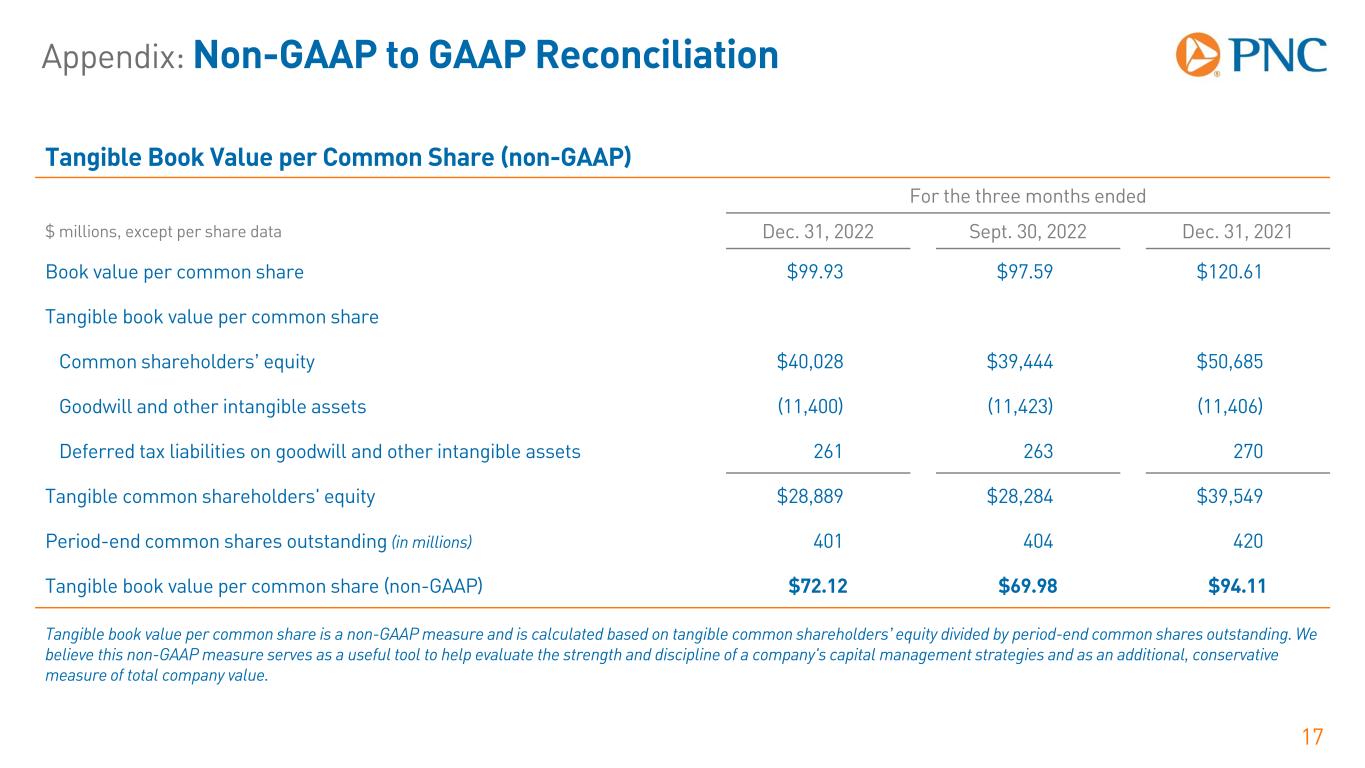
Appendix: Non-GAAP to GAAP Reconciliation 17 Tangible Book Value per Common Share (non-GAAP) For the three months ended $ millions, except per share data Dec. 31, 2022 Sept. 30, 2022 Dec. 31, 2021 Book value per common share $99.93 $97.59 $120.61 Tangible book value per common share Common shareholders’ equity $40,028 $39,444 $50,685 Goodwill and other intangible assets (11,400) (11,423) (11,406) Deferred tax liabilities on goodwill and other intangible assets 261 263 270 Tangible common shareholders' equity $28,889 $28,284 $39,549 Period-end common shares outstanding (in millions) 401 404 420 Tangible book value per common share (non-GAAP) $72.12 $69.98 $94.11 Tangible book value per common share is a non-GAAP measure and is calculated based on tangible common shareholders’ equity divided by period-end common shares outstanding. We believe this non-GAAP measure serves as a useful tool to help evaluate the strength and discipline of a company's capital management strategies and as an additional, conservative measure of total company value.
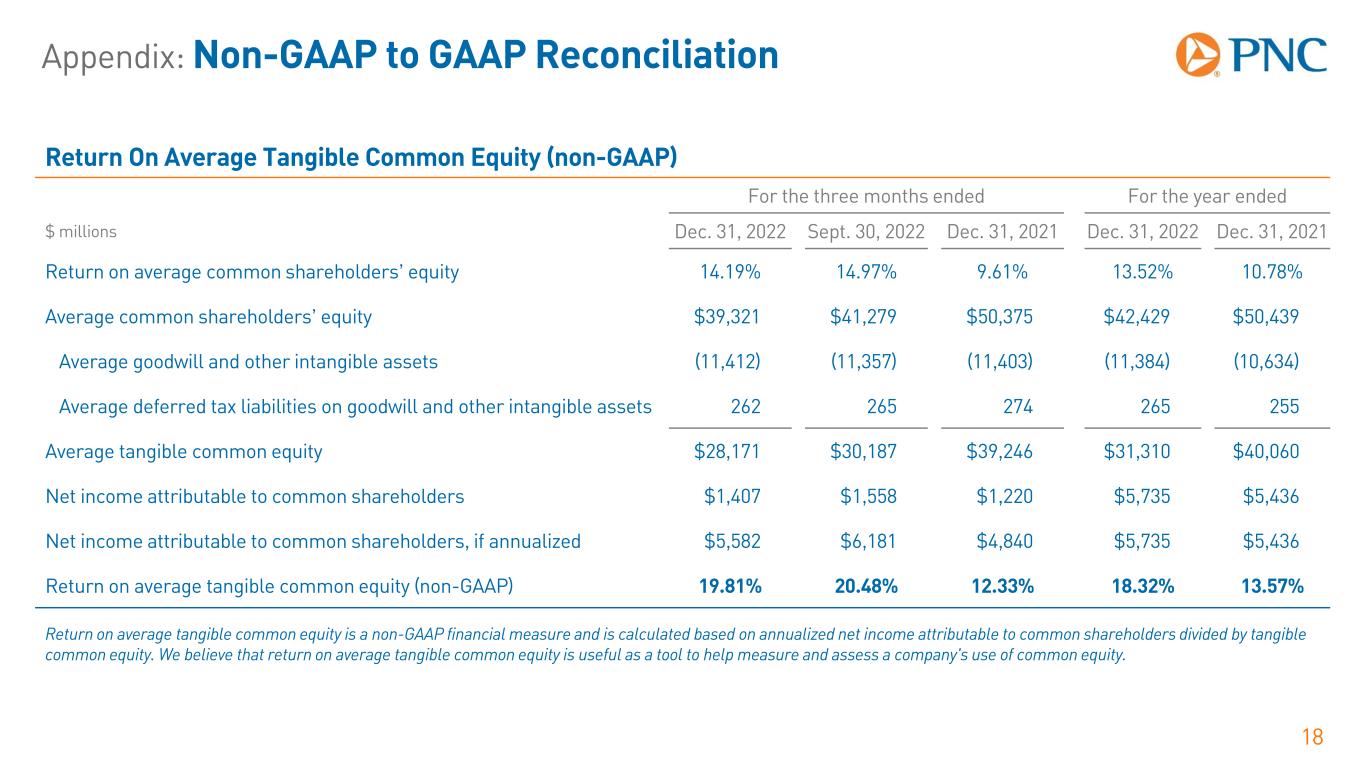
Appendix: Non-GAAP to GAAP Reconciliation 18 Return On Average Tangible Common Equity (non-GAAP) For the three months ended For the year ended $ millions Dec. 31, 2022 Sept. 30, 2022 Dec. 31, 2021 Dec. 31, 2022 Dec. 31, 2021 Return on average common shareholders’ equity 14.19% 14.97% 9.61% 13.52% 10.78% Average common shareholders’ equity $39,321 $41,279 $50,375 $42,429 $50,439 Average goodwill and other intangible assets (11,412) (11,357) (11,403) (11,384) (10,634) Average deferred tax liabilities on goodwill and other intangible assets 262 265 274 265 255 Average tangible common equity $28,171 $30,187 $39,246 $31,310 $40,060 Net income attributable to common shareholders $1,407 $1,558 $1,220 $5,735 $5,436 Net income attributable to common shareholders, if annualized $5,582 $6,181 $4,840 $5,735 $5,436 Return on average tangible common equity (non-GAAP) 19.81% 20.48% 12.33% 18.32% 13.57% Return on average tangible common equity is a non-GAAP financial measure and is calculated based on annualized net income attributable to common shareholders divided by tangible common equity. We believe that return on average tangible common equity is useful as a tool to help measure and assess a company's use of common equity.
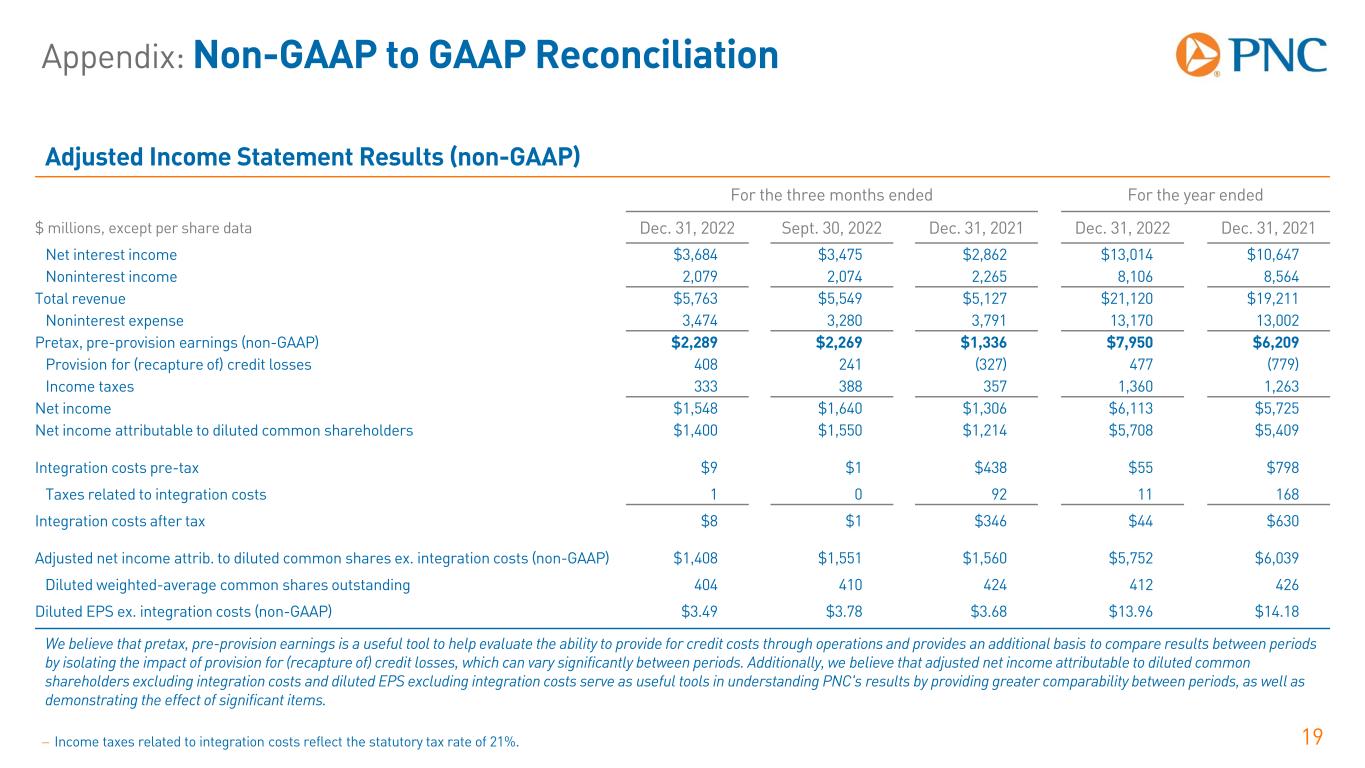
Appendix: Non-GAAP to GAAP Reconciliation 19− Income taxes related to integration costs reflect the statutory tax rate of 21%. Adjusted Income Statement Results (non-GAAP) For the three months ended For the year ended $ millions, except per share data Dec. 31, 2022 Sept. 30, 2022 Dec. 31, 2021 Dec. 31, 2022 Dec. 31, 2021 Net interest income $3,684 $3,475 $2,862 $13,014 $10,647 Noninterest income 2,079 2,074 2,265 8,106 8,564 Total revenue $5,763 $5,549 $5,127 $21,120 $19,211 Noninterest expense 3,474 3,280 3,791 13,170 13,002 Pretax, pre-provision earnings (non-GAAP) $2,289 $2,269 $1,336 $7,950 $6,209 Provision for (recapture of) credit losses 408 241 (327) 477 (779) Income taxes 333 388 357 1,360 1,263 Net income $1,548 $1,640 $1,306 $6,113 $5,725 Net income attributable to diluted common shareholders $1,400 $1,550 $1,214 $5,708 $5,409 Integration costs pre-tax $9 $1 $438 $55 $798 Taxes related to integration costs 1 0 92 11 168 Integration costs after tax $8 $1 $346 $44 $630 Adjusted net income attrib. to diluted common shares ex. integration costs (non-GAAP) $1,408 $1,551 $1,560 $5,752 $6,039 Diluted weighted-average common shares outstanding 404 410 424 412 426 Diluted EPS ex. integration costs (non-GAAP) $3.49 $3.78 $3.68 $13.96 $14.18 We believe that pretax, pre-provision earnings is a useful tool to help evaluate the ability to provide for credit costs through operations and provides an additional basis to compare results between periods by isolating the impact of provision for (recapture of) credit losses, which can vary significantly between periods. Additionally, we believe that adjusted net income attributable to diluted common shareholders excluding integration costs and diluted EPS excluding integration costs serve as useful tools in understanding PNC's results by providing greater comparability between periods, as well as demonstrating the effect of significant items.
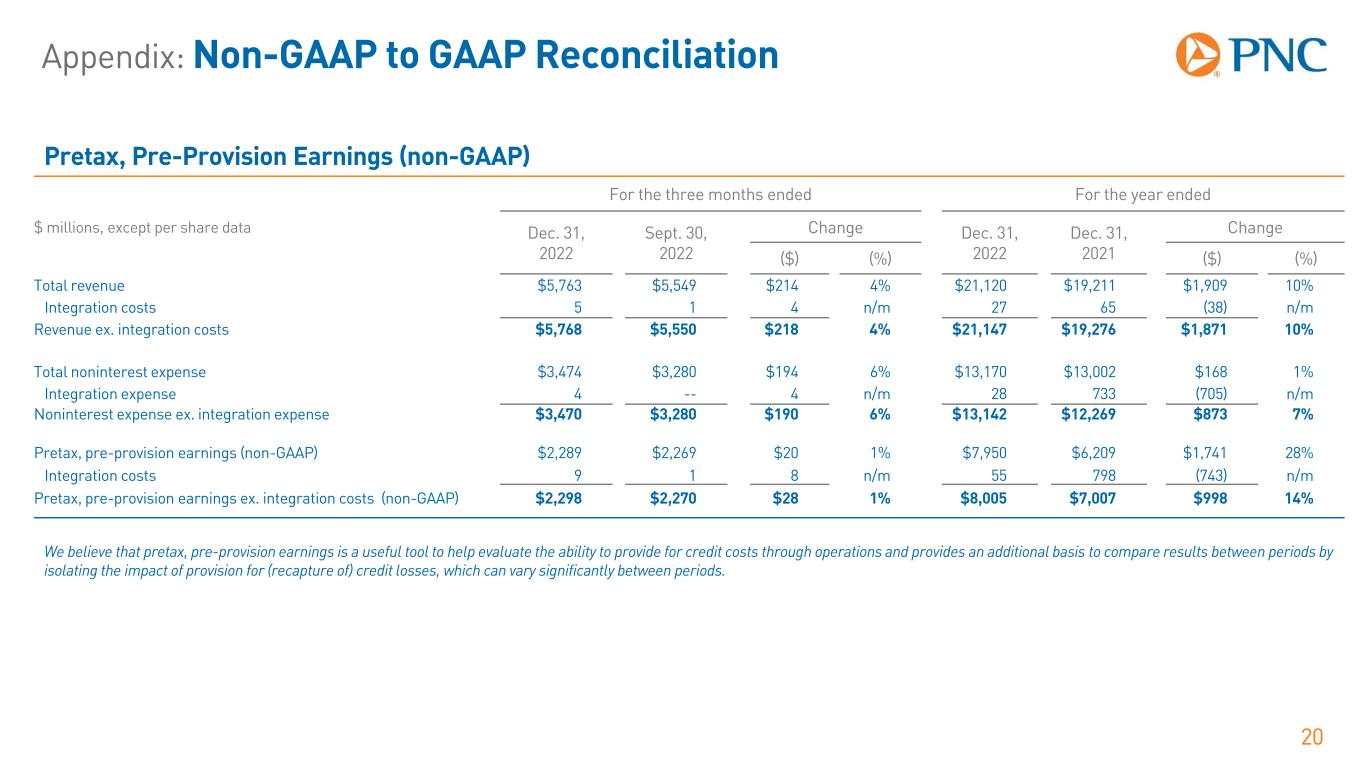
Appendix: Non-GAAP to GAAP Reconciliation 20 Pretax, Pre-Provision Earnings (non-GAAP) ` For the three months ended For the year ended $ millions, except per share data Dec. 31, 2022 Sept. 30, 2022 Change Dec. 31, 2022 Dec. 31, 2021 Change ($) (%) ($) (%) Total revenue $5,763 $5,549 $214 4% $21,120 $19,211 $1,909 10% Integration costs 5 1 4 n/m 27 65 (38) n/m Revenue ex. integration costs $5,768 $5,550 $218 4% $21,147 $19,276 $1,871 10% Total noninterest expense $3,474 $3,280 $194 6% $13,170 $13,002 $168 1% Integration expense 4 -- 4 n/m 28 733 (705) n/m Noninterest expense ex. integration expense $3,470 $3,280 $190 6% $13,142 $12,269 $873 7% Pretax, pre-provision earnings (non-GAAP) $2,289 $2,269 $20 1% $7,950 $6,209 $1,741 28% Integration costs 9 1 8 n/m 55 798 (743) n/m Pretax, pre-provision earnings ex. integration costs (non-GAAP) $2,298 $2,270 $28 1% $8,005 $7,007 $998 14% We believe that pretax, pre-provision earnings is a useful tool to help evaluate the ability to provide for credit costs through operations and provides an additional basis to compare results between periods by isolating the impact of provision for (recapture of) credit losses, which can vary significantly between periods.
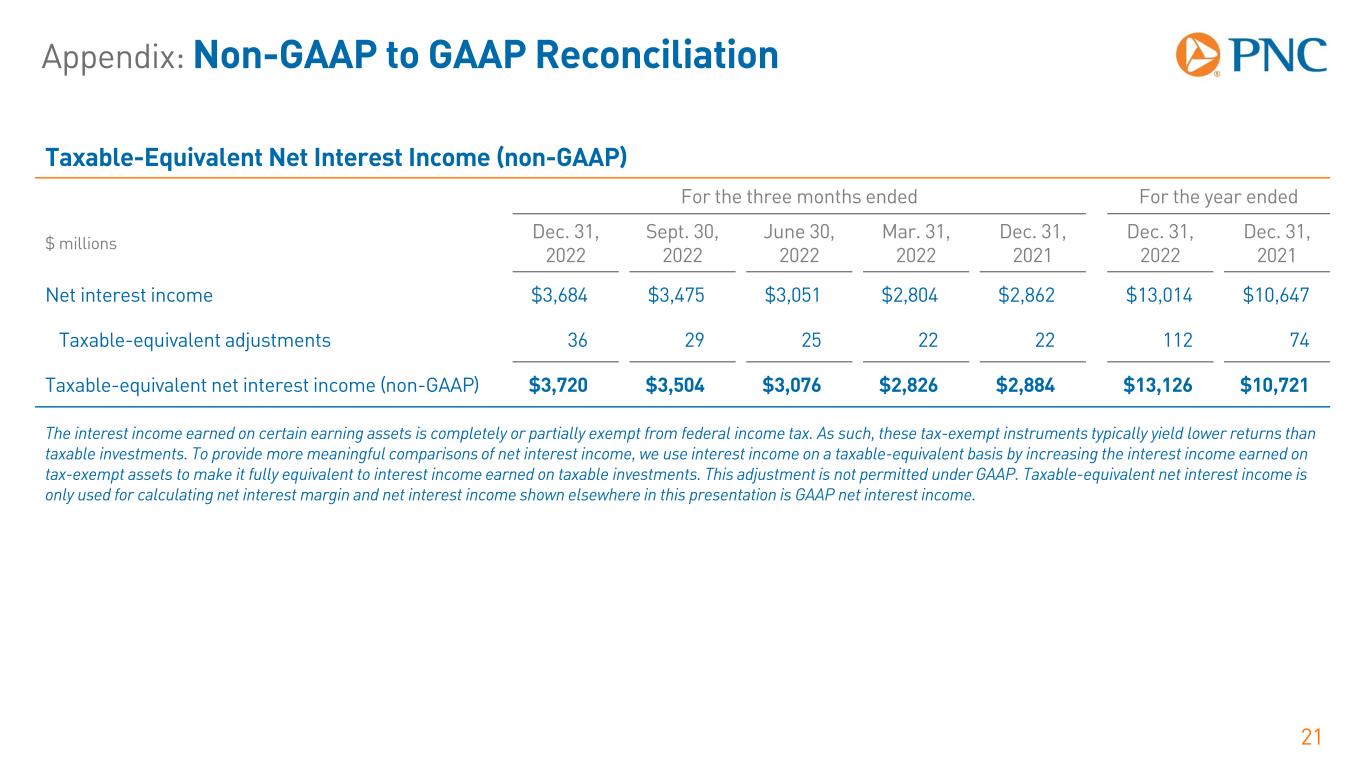
Appendix: Non-GAAP to GAAP Reconciliation 21 Taxable-Equivalent Net Interest Income (non-GAAP) For the three months ended For the year ended $ millions Dec. 31, 2022 Sept. 30, 2022 June 30, 2022 Mar. 31, 2022 Dec. 31, 2021 Dec. 31, 2022 Dec. 31, 2021 Net interest income $3,684 $3,475 $3,051 $2,804 $2,862 $13,014 $10,647 Taxable-equivalent adjustments 36 29 25 22 22 112 74 Taxable-equivalent net interest income (non-GAAP) $3,720 $3,504 $3,076 $2,826 $2,884 $13,126 $10,721 The interest income earned on certain earning assets is completely or partially exempt from federal income tax. As such, these tax-exempt instruments typically yield lower returns than taxable investments. To provide more meaningful comparisons of net interest income, we use interest income on a taxable-equivalent basis by increasing the interest income earned on tax-exempt assets to make it fully equivalent to interest income earned on taxable investments. This adjustment is not permitted under GAAP. Taxable-equivalent net interest income is only used for calculating net interest margin and net interest income shown elsewhere in this presentation is GAAP net interest income.

Appendix: Non-GAAP to GAAP Reconciliation 22 Noninterest Expense excluding Integration Expense and Adjusted Efficiency (non-GAAP) For the three months ended For the year ended $ millions Dec. 31, 2022 Sept. 30, 2022 Dec. 31, 2022 Dec. 31, 2021 Noninterest expense $3,474 $3,280 $13,170 $13,002 Integration expense (4) --- (28) (733) Noninterest expense excluding integration expense (non-GAAP) $3,470 $3,280 $13,142 $12,269 Revenue $5,763 $5,549 $21,120 $19,211 Integration costs – contra revenue (5) (1) (27) (65) Revenue excluding integration cost - contra revenue (non-GAAP) $5,768 $5,550 $21,147 $19,276 Efficiency ratio 60% 59% 62% 68% Adjusted efficiency ratio (non-GAAP) 60% 59% 62% 64% We believe that noninterest expense excluding integration expense is a useful tool for the purposes of evaluating and guiding for future expenses that are operational in nature and expected to recur over time as opposed to those related to the integration of BBVA USA. While we expect to have more integration expense as the process continues, these costs are not core to the operation of our business on a forward basis. Also, we believe that noninterest expense excluding integration expense and adjusted efficiency serve as useful tools in understanding PNC's results by providing greater comparability between periods, demonstrating the effect of significant items, and providing useful measures for determining PNC's revenue and expenses that are core to our business operations and expected to recur over time.